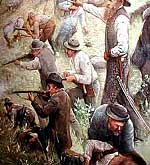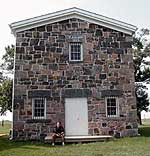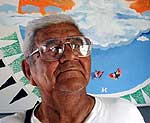By Mark Steil and Tim Post
Minnesota Public Radio
September 26, 2002
| |
|
|
|
||
The Civil War battlefields were bloody in the summer of 1862. Minnesotans were shocked by the number of soldiers killed. But problems were building in their own state.
The Dakota reservation was a place of unhappiness and unrest. The Indians lived along the Minnesota River - the reservation went from New Ulm to the South Dakota border. In the summer of 1862, the Dakota were hungry. Dan Fjeld of the Minnesota Historical Society says their crops had failed the previous fall.
"There's a potato blight, and there's an infestation of bugs, and the crops fail. Because of what's going on here, the Dakota don't get out on the fall hunt to the extent that they would like to," Fjeld says. "Then in the winter of '61-'62 - terrible winter, terrible winter. Heavy snows, everybody's snowed in and people are starving."
Fjeld stands near a stone warehouse that survived the war. It was stocked with food in 1862, but the government refused to hand it out. In an earlier treaty the government promised to support the tribe with food and yearly payments. But in 1862, the government money was late.
| |
|
|
|
||
Indian agent Thomas Galbraith was a stickler for policy. The food and the money were always distributed together. He held to that in 1862 - with disastrous results.
"Thomas Galbraith really dropped the ball. He drug his feet. He should have distributed the food. There were Dakota starving out here," says Fjeld. "The Dakota would say, 'We need food,' he'd hand out small bits of it - a little bit here and there."
Tensions built through the summer. At one point, hundreds of Dakota began carrying off food from a storehouse. They were stopped by soldiers armed with cannon. There was a meeting between the government, Indians and traders. One of the traders was Andrew Myrick.
Fjeld says the meeting broke down when Myrick made one of the most infamous comments in Minnesota history. To set the stage, Fjeld says first an Indian spoke.
"'This is our reservation, and yet you go out and you cut our grass for your animals. You cut down our trees for your building and your fire. You shoot our game, which we have very little of anyway. It's ours, you leave it alone,'" Fjeld quotes the Indian as saying.
| |
|
|
|
||
"And Andrew Myrick says, 'Well then, if you want it then you eat your grass. And we won't trade with you.'" The interpreter - he doesn't want to say it. He's forced to say it. And it's said that a hush just falls over the entire Dakota. Just for an instant it's dead quiet. And a yell erupts from out of the Dakota people. Some describe it as almost a battle cry," says Fjeld.
Myrick's "let them eat grass" remark was dehumanizing. It implied Indians were like horses or cattle.
Soon after, the killing began. On Aug. 17, a Dakota hunting party killed several settlers about 40 miles north of the reservation. This strike sparked intense debate on the reservation - many Indians favored war to clear the Minnesota River Valley of settlers.
Elmer Weston is 81 years old. He lives on the Flandreau Indian Reservation in eastern South Dakota. As a young boy, he can remember his grandfather and others talking about what they saw in 1862. Weston says on Aug. 18, an Indian covered his shotgun with a blanket and walked into a reservation store.
"He said, 'I want to show you people how to do things.' He walked by this clerk, sitting at this table writing something. When he went by there, he pulled the trigger and he shot him. That was the first white man they killed there," Weston says.
Among the many casualties that day was the trader Andrew Myrick. He was found with grass stuffed in his mouth.
More from MPR


